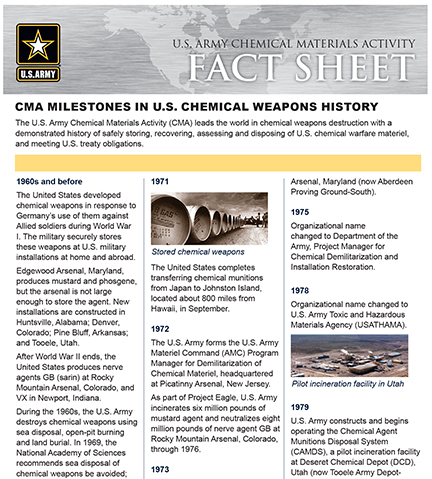Milestones in U.S. Chemical Weapons History
CMA Fact Sheets
[rpwe limit=”50″ thumb=”” post_type=”page” date=”” styles_default=”false” order=”DES” orderby=”title” cat=”7″ tag=”9″]
The mountain has been an element that has graced many of the past depot emblems, representing Pike’s Peak.
The Pershing Missile in the center represents one of the most prominent missions of the depot in the 1980s.
The hawk represents native depot wildlife, the present and future mission of the environmental programs, and was also the name of one of the missile systems supplied by the depot during its missile mission in the 1950s and 60s.
The branch insignia of both the U.S. Army Chemical Corps and Ordnance Corps represent the depot’s command structure through its history as both an ordnance and a chemical depot.
The colors cobalt blue and yellow gold are representative of the U.S. Army Chemical Corps. “Pueblo Depot” is representative of the installation throughout its history. “1942” is the date of establishment. “Safety” and “Service” capture the continued and historical depot missions.
The motto translates to “A Common Good.”
The rising sun denotes the dawning of a new day without chemical weapons and the organization’s mission to safely destroy chemical weapons stockpile, thus changing the future of modern warfare.
The three stalks of wheat symbolize the harvest of hope that has been secured through industry, cultivation and abundance. It also refers to the unit’s chemical/biological, smoke/obscurant and support to Homeland security industrial base missions at Pine Bluff Arsenal.
The double-headed eagle suggests the two CMA methods for stockpile chemical weapons disposal, incineration and neutralization. These methods’ roots are traced back to Project Eagle I (incinerating of mustard agents) and Eagle II (neutralizing nerve agents).
The olive branch signifies peace and the Activity’s commitment to abide by the stipulations of the Chemical Weapons Convention Treaty and assisting other nations.
The octagon alludes to the eight original chemical weapons stockpile storage sites in the United States.

